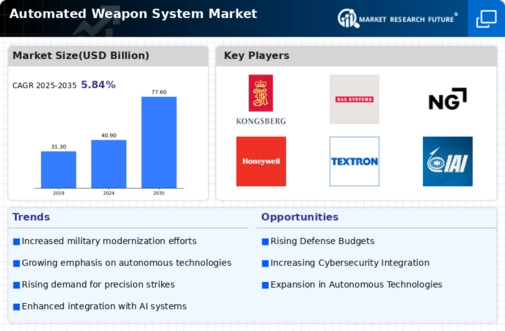The Automated Weapon System Market has been witnessing significant advancements, driven by rapid technological evolution and increasing defense budgets across various nations. The competitive landscape is characterized by a mix of established defense contractors and emerging players, each striving to enhance their offerings in response to rising security threats.
The integration of automation, artificial intelligence, and robotics into remote weapons systems is transforming conventional warfare, leading to improved efficiency, accuracy, and safety on the battlefield. As nations prioritize modernization of their military capabilities, the market dynamics reflect a shift towards automated solutions that offer greater operational adaptability and precision.
This competitive environment encourages continuous innovation, strategic collaborations, and mergers to capitalize on growth opportunities, especially in regions experiencing heightened geopolitical tensions.
General Dynamics is a prominent player in the Automated Weapon System Market, recognized for its robust portfolio of advanced military technologies and solutions. The company's strengths lie in its extensive experience in defense contracting and its ability to integrate cutting-edge technologies into automated weapon systems.
General Dynamics has a strong market presence due to its commitment to research and development, allowing it to remain at the forefront of innovation in weapon systems. This focus enables the company to respond rapidly to emerging threats and evolving operational requirements.
Additionally, General Dynamics benefits from its established relationships with government agencies and military organizations, ensuring consistent demand for its automated solutions. The company's emphasis on quality and reliability enhances its reputation among defense procurement authorities, setting it apart from competitors in the rapidly evolving automated weapon market.
Kongsberg Gruppen has established itself as a significant entity within the Automated Weapon System Market, leveraging its technology and expertise in defense and aerospace. The company is recognized for delivering integrated solutions that combine sensors, effectors, and command and control systems, enhancing the operational effectiveness of automated weapons.
Kongsberg Gruppen's strength lies in its innovative product line, including advanced missile systems and unmanned platforms, which are increasingly being integrated into defense strategies worldwide. The company has successfully capitalized on its strategic partnerships and collaborations with military forces around the globe, enabling it to expand its market reach.
Kongsberg's commitment to sustainability and efficient defense solutions resonates with current military procurement trends, positioning the company favorably in the competitive landscape. With a strong focus on future technologies and continuous improvement, Kongsberg Gruppen is poised to play a pivotal role in shaping the evolution of automated weapon systems in the coming years.


















Leave a Comment